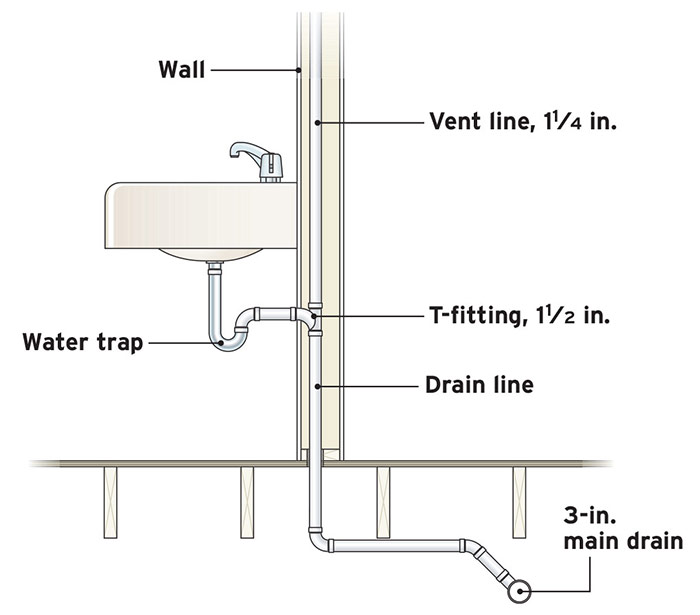Maintaining Adequate Ventilation in Your Plumbing System: The Reason
Maintaining Adequate Ventilation in Your Plumbing System: The Reason
Blog Article
Just how do you actually feel about What Is A Plumbing Vent & How Do They Work??

Correct ventilation in pipes systems is usually neglected, yet it is vital for preserving the performance and safety of your home's pipes. Air flow assists manage atmospheric pressure, protect against the build-up of damaging gases, and ensure the reliable elimination of waste. In this guide, we will check out the relevance of correct pipes air flow, just how it functions, and the advantages it gives your pipes system.
Comprehending Ventilation in Plumbing
Ventilation in pipes describes the network of pipelines that enable air to flow through the water drainage system. These vents offer several functions, including managing atmospheric pressure within the pipelines, stopping sewage system gases from getting in the home, and aiding in the smooth flow of wastewater.
Just How Air Flow Works in Plumbing Solutions
Atmospheric Pressure Guideline
Appropriate ventilation maintains well balanced air pressure within the plumbing system. When water flows with pipelines, it displaces air. Without appropriate air flow, this displacement can produce adverse pressure, bring about slow drains or siphoning of water from catches, which can create undesirable odors to leak right into the home.
Protecting Against Sewer Gas Accumulation
One of one of the most critical functions of plumbing vents is to prevent drain gases, such as methane and hydrogen sulfide, from collecting within the home. These gases can present severe wellness dangers and are extremely flammable. Vent pipes enable these gases to run away safely outside.
Aiding in Waste Removal
Air flow helps in the effective elimination of wastewater by preventing airlocks in the drainage system. When air can move easily with the vents, it allows water and waste to move smoothly through the pipelines, minimizing the risk of obstructions and backups.
Sorts Of Plumbing Vents
Key Stack Vent
The major stack air vent, likewise known as the air vent stack, is the key air vent in a pipes system. It prolongs from the major drain align via the roof, permitting gases to get away and fresh air to enter the system.
Branch Vent
Branch vents connect to the main stack vent and offer individual fixtures, such as sinks, toilets, and showers. These vents make certain that each fixture has sufficient air flow to function appropriately.
Air Admission Shutoff (AAV).
An Air Admission Shutoff (AAV) is a one-way shutoff that permits air to get in the pipes system without the demand for a traditional vent pipeline expanding via the roof covering. AAVs are generally made use of in renovations or areas where installing a conventional vent is impractical.
Signs of Poor Ventilation in Pipes.
Slow Draining Fixtures.
If your sinks, bathtubs, or commodes are draining gradually, it could be an indication of poor ventilation. Poor air flow can produce a vacuum cleaner effect, making it tough for water to drain pipes correctly.
Gurgling Seems.
Gurgling audios coming from drains are usually a result of air being sucked through water catches because of negative stress in the pipes. This is a clear indicator of not enough ventilation.
Undesirable Smells.
Sewage system odors inside your home are a red flag that your plumbing system is not effectively aerated. This could imply that drain gases are not being adequately vented outside, resulting in possibly unsafe conditions.
Common Ventilation Blunders.
Poor Vent Sizing.
Using undersized vent pipes can cause bad air circulation and pressure imbalances in the system. It's essential to make use of vents that satisfy the specific needs of your plumbing system.
Improper Vent Placement.
Putting vents too much from the fixtures they offer can minimize their effectiveness. Correct positioning ensures that air can stream freely and effectively via the system.
Ignoring Code Demands.
Building regulations supply particular standards for plumbing ventilation. Ignoring these codes can lead to a system that falls short to function properly and might lead to costly repair services or carcinogen.
Advantages of Proper Ventilation.
Enhanced System Effectiveness.
Appropriately aerated pipes systems run a lot more successfully, with less obstructions, faster draining, and less pressure on the pipelines. This efficiency prolongs the life expectancy of the pipes system.
Improved Air Quality.
By avoiding drain gases from entering your home, correct air flow adds to far better interior air quality, making your living setting healthier and much more comfortable.
Avoiding Water Damages.
Adequate air flow assists prevent water from being siphoned out of traps, which can cause drain gases going into the home and triggering water damage in time.
Steps to Make Certain Proper Ventilation.
Consulting Pipes Codes.
Always speak with local pipes codes when developing or modifying your pipes system. These codes offer the necessary standards for proper airing vent and ensure your system satisfies safety criteria.
Regular Examination and Maintenance.
Normal evaluations can aid identify prospective air flow issues before they come to be major problems. Upkeep jobs, such as cleaning vent pipes and looking for blockages, are necessary for maintaining the system in good working order.
Professional Installment.
For brand-new installments or significant alterations, it's a good idea to employ a specialist plumbing professional. They have the know-how to make certain the air flow system is appropriately made and mounted according to code.
Verdict.
Appropriate ventilation is a critical component of any kind of plumbing system, guaranteeing that it functions successfully and securely. By understanding the importance of air flow, acknowledging the indicators of bad ventilation, and taking actions to preserve your system, you can protect against expensive issues and shield your home's air high quality.
4 Things You Should Know About Your Plumbing Vents
What Plumbing Vents Are
Also called a vent stack, a plumbing vent is a vertical pipe attached to your drain line that runs through your roof. The plumbing vent pipe, or plumbing air vent, removes gas and odors from your plumbing system and allows fresh air to enter the pipes, helping the water to flow out of the drain pipes.
What Plumbing Vents Do
Plumbing vents have two basic functions. One of which is to allow unpleasant smelling wastewater and sewer gasses to escape your plumbing system instead of entering your home. Plumbing vent pipes are typically located on roofs, away from windows, to ensure the fumes exit the home completely.
The other function of the plumbing vent is to move fresh air into your plumbing system. This helps move water through every plumbing fixture in your house, like toilets and sink drains. Think of the way in which you need to let a little air into the bottle as you pour soda in order to make the drink flow smoothly.
Different Types of Plumbing Vents
True vent: This is the most common vent option. In simplest terms, a true vent is a vertical pipe attached to your drain line that exits through the roof. They often function as the main vent that other fixtures can connect to. Re-vent pipe or auxiliary vent: Attached to the drain line near specific plumbing fixtures, re-vent pipes run up and over to connect to the main vent. Common vent: Two plumbing fixtures installed on opposite sides of a wall are typically tied into the vent stack using something known as a sanitary cross. Wet vent: This venting option operates as a drain pipe and a vent at the same time. Wet vent drainage systems drain water from one fixture while venting the air from another. Although they’ve been used for over 100 years, wet vent systems have only recently been added to the plumbing code in many areas. If you’re planning on installing one in a bathroom remodel, make sure you check your local code prior to construction. Loop vent: For free-standing fixtures like kitchen island sinks, loop vents are ideal. These vent pipes run under the floor, rise from the P-trap, and create a loop inside the cabinet sink. Air admittance valve: An AAV is a one-way mechanical valve typically installed at the site of the plumbing fixture. AAVs allow venting to occur without having to tie into a larger venting system. They’re ideal for venting fixtures where you aren’t able to easily connect to an existing vent system. Common Plumbing Vent Issues
Although vent pipes typically don’t have water flowing through them, they’re still subject to many typical plumbing issues. For example, clogs are one of the most common problems associated with sewer vent pipes. If your vent pipe gets clogged, all of your plumbing fixtures tied into the vent stack will be affected.
A sink with a slow drain that bubbles and gurgles or a strong sewage smell around your toilet are both indicators that your toilet vent pipe is clogged. Because most vent pipes exit through the roof, old leaves, twigs or even a bird’s nest could be clogging the pipe.
Clogs in your vent pipe system cause a buildup of negative pressure, meaning that water won’t be able to flow out of your home very well. It’s similar to putting your finger over the opening of a straw to trap water inside. When you remove your finger, the water is able to flow out of the straw.
If you suspect you have any blockage in your vent, make sure you have a professional come examine the situation. Left unchecked, a blocked air vent can lead to other costly repairs, like leaks and sediment buildup.
Under Pressure
Pipe vents are essential aspects of a home’s plumbing system. Owning a home means learning about all sorts of things you never put much thought into before. But by understanding as much as you can about the important systems of your home, you can keep those budgets intact and those anxiety levels low.
https://www.homeserve.com/en-us/blog/home-improvement/plumbing-vents/

As a keen reader on What Are Plumbing Vents and Why Are They Important?, I figured sharing that excerpt was important. Are you aware of someone else who is in to the niche? Feel free to share it. Thanks a lot for going through it.
Book A Service Call Report this page